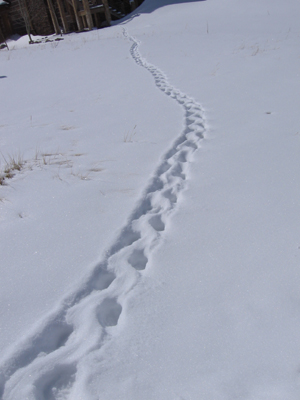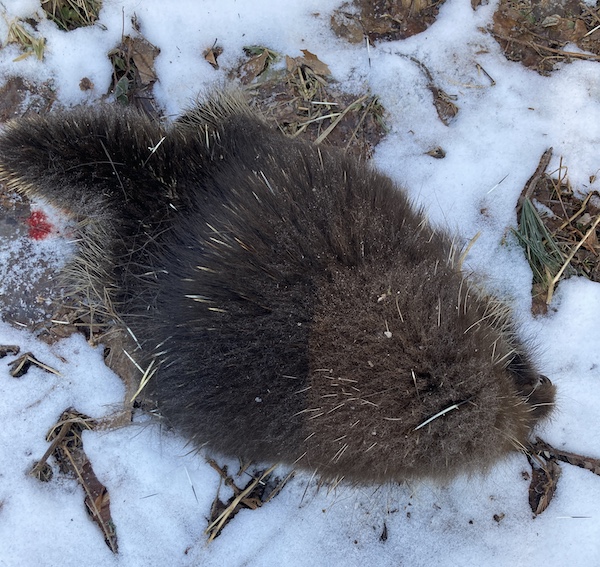
I neglected to take a shot of my tracks
Our mystery animal turned out to be a big porcupine. For several months, I was content to leave him be. When he started eating on my best apple tree, he crossed the line. I set my defenses and caught him at the scene of the crime.
All winter, we’ve seen some mystery tracks in the snow. They were two parallel lines, (unlike the nearly straight-line tracks of fox or coyote) The prints were close together, so whatever it was, had short legs. The trails always led up to a tree and then away from it. Mystery animal was shambling through the snow to go climb a tree, then come back down to shamble off somewhere else.
We thought it might be a fisher. I’d caught one a couple of years ago. They like to climb trees. Curiously, the (supposed) fisher never showed any interest in the chicken coops — just the trees.
One morning back in early February, the mystery tracks had run right past the coop. That meant I would have a video of whatever it was. Playback from the camera that watches the backside of the coop clearly revealed that our mystery animal was a very fat porcupine. I knew porcupines eat tree bark, but he seemed content to climb and gnaw on the many hemlocks along my side hill. As long as that’s all he was up to, I wasn’t concerned.
A few days ago, however, the nightly trails in the snow zigzagged around the fruit trees and led right up to my best-producing apple tree. To my horror, a central trunk-branch had been stripped of bark! Other branches had big holes gnawed in their thin, smooth bark. The days of leaving the porcupine alone were over. In just a few nights, he could strip the bark off all of my fruit trees. He had to die.

That day, I circled the wounded tree with a roll of chicken wire. It wouldn’t stop a determined attacker, of course, but it might befuddle him a bit and prompt him to look for an easy way around the barrier.
I got out my spare wireless “driveway” alarm. Which turned out to be the technological advantage I needed. I have two sensors that watch the coop. I had a third as a spare. I got them from Amazon. (affiliate link, btw) I really like them. They’re fairly inexpensive and have worked quite well over many years, alerting me to raccoons and weasels messing around the chicken coop so I could discourage them before they had time to find a way inside. The sensors themselves run on a 9v battery (I use rechargeables) so they can be placed anywhere within range. They say up to 800′ but mine are no more than 100′ from the base, so I can’t vouch for the claim. The base station in the house plugs into a 120VAC outlet, but runs on 12v DC ultimately, so it could be run off a battery. This extra sensor I set up on a tripod facing my chicken wire fencing. If the criminal returned to the scene, I would be notified. I positioned the twenty-two and a flashlight beside the backdoor before going to bed, just in case I had to react quickly.

Sure enough, at 5:25 that next morning, the alarm went off. I threw on some pants, shoes, and the ‘chores’ coat I keep near the door. I grabbed the “discouragement tool” and ran out back.
There he was, beside the fence. Porcupines can’t move fast. They usually have no reason to. Fishers are the only predator that messes with porcupines. Somehow, this one knew I would not be put off with his quills defense, so he was waddling as fast as his stubby little legs would carry him. He was headed toward the gap between the well and the shed and escape over the frozen pond.
The pre-dawn light was too dim, and he was only six feet away — too close to use the scope. He was little more than a dark shape, speed-waddling over the somewhat lighter snow. I could only aim indirectly, like they do in movies. I ran along, parallel to his path, squeezing off “applications” as I ran. This isn’t to make the event sound like a Hollywood action flick, though, in the moment, it kind did feel like that.
It took six applications to stop him. Fat critters can be rather hard to discourage. He got between the well and the shed but slowed to a stop before the edge of the pond. My apple tree’s attacker had been…reformed.

I left the chicken wire fence up and the sensor aimed, just in case I had more than one porcupine. Thus far, no accomplices have shown up. Only a rabbit has set off the alarm since.

I applied some tree-wound “tar” (actually, a latex product) to the damaged bark, in hopes that the gnawed branches might heal eventually. That central trunk-branch is a goner, though. My poor tree probably won’t do much this year while it tries to heal from the ravaging of a fat and hungry porcupine.
While I might have fewer apples in this coming fall’s harvest, I do have the satisfaction of knowing that the criminal was brought to justice.
—


Mic you might want to look at doing a cleft graft to replace that badly chewed central part of your apple tree.
https://thefruithouse.weebly.com/cleft-grafting.html
Even grafts from above that crewed area can be used give the season.
A ring of welded wire fencing with a single fence post has protected my apple trees so far from all pests along with that plastic spiral anti-vole guard.
That reminds me I need to buy more welded wire fencing. Never goes bad unless you run over it and very hard to make a substitute.
Hi Michael, Thanks for the link and idea about the cleft graft. I might just do that for that central “trunk”. Good reminder about getting a roll or two of welded wire. Always useful to have on hand.